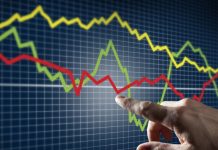 Answer: Every trader, every analyst and every technician has favorite techniques to use when trading. But where traditional technical studies fall short, the Wave Principle kicks in to show high-confidence price targets. Just as important, it can distinguish high probability trade setups from the ones that traders should ignore.
Answer: Every trader, every analyst and every technician has favorite techniques to use when trading. But where traditional technical studies fall short, the Wave Principle kicks in to show high-confidence price targets. Just as important, it can distinguish high probability trade setups from the ones that traders should ignore.
Here are five ways the Wave Principle improves trading:
1. Identifies Trend
The Wave Principle identifies the direction of the dominant trend. A five-wave advance identifies the overall trend as up. Conversely, a five-wave decline determines that the larger trend is down. Why is this information important? Because it is easier to trade in the direction of the dominant trend, since it is the path of least resistance and undoubtedly explains the saying, “the trend is your friend.”
2. Identifies Countertrend
Wave Principle also identifies countertrend moves. A three-wave pattern is a corrective response to the preceding impulse wave. Knowing that a recent move in price is merely a correction within a larger trending market is especially important for traders because corrections are opportunities to position yourselves in the direction of the larger trend of a market.
3. Determines Maturity of a Trend
As Elliott observed, wave patterns form larger and smaller versions of themselves. This repetition in form means that price activity is fractal, as illustrated in Figure 2-1. Wave (1) subdivides into five small waves, yet is part of a larger five-wave pattern.
How is this information useful?
It helps traders recognize the maturity of a trend. If prices are advancing in wave 5 of a five-wave advance for example, and wave 5 has already completed three or four smaller waves, a trader knows this is not the time to add long positions. Instead, it may be time to take profits or at least to raise protective stops.
4. Provides Price Targets
Traditional technical studies simply don’t offer high-confidence price targets the Wave Principle can provide. When R.N. Elliott wrote about the Wave Principle in Nature’s Law, he stated that the Fibonacci sequence was the mathematical basis for the Wave Principle. Elliott waves, both impulsive and corrective, adhere to specific Fibonacci proportions, as illustrated in Figure 2-2. For example, common objectives for wave 3 are 1.618 and 2.618 multiples of wave 1. In corrections, wave 2 typically ends near the .618 retracement of wave 1, and wave 4 often tests the .382 retracement of wave 3. These high-confidence price targets allow traders to set profit-taking objectives or identify regions where the next turn in prices will occur.
5. Provides Specific Points of Ruin
At what point does a trade fail? Many traders use money management techniques to determine the answer to this question, because technical studies simply don’t offer one.
Yet the Wave Principle does provide a more “technical” validation in the form of Elliott Rules
Rule 1: Wave 2 can never retrace more than 100% of wave 1.
Rule 2: Wave 4 may never end in the price territory of wave 1.
Rule 3: Out of the three impulse waves — 1, 3 and 5 — wave 3 can never be the shortest.
A violation of one or more of these rules implies that the operative wave count is incorrect. How can traders use this information? If a technical study warns of an upturn in prices, and the wave pattern is a second wave pullback, the trader knows specifically at what point the trade will fail — a move beyond the origin of wave 1. That kind of guidance is difficult to come by without a framework like the Wave Principle.
Technical studies can pick out many trading opportunities, but the Wave Principle helps traders discern which ones have the highest probability of being successful. This is because the Wave Principle is the framework that provides history, current information and a peek at the future. When traders place their technical studies within this strong framework, they have a better basis for understanding current price action.
* * * * * * * *
This answer is from Jeffrey Kennedy, Senior Instructor and Analyst at Elliott Wave International. You can learn how to apply the Elliott Wave Principle to your trading in a newly-released 15-minute video from Jeffrey Kennedy, Introduction to the Wave Principle Applied.
Free 15-minute video
|
This article was syndicated by Elliott Wave International and was originally published under the headline How Can The Elliott Wave Principle Improve My Trading?. EWI is the world’s largest market forecasting firm. Its staff of full-time analysts led by Chartered Market Technician Robert Prechter provides 24-hour-a-day market analysis to institutional and private investors around the world.









![How to install MetaTrader 4 / 5 on MacOS Catalina? Simple way. [VIDEO]](https://comparic.com/wp-content/uploads/2020/07/mt4-os-218x150.jpg)








